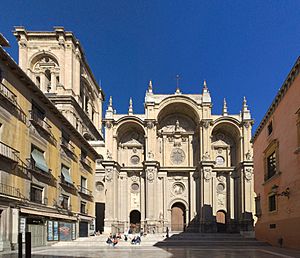Granada Cathedral facts for kids
Quick facts for kids Granada Cathedral |
|
|---|---|
| Metropolitan Cathedral Basilica of the Incarnation | |
| Basílica Catedral Metropolitana de la Encarnación | |

West façade
|
|
| 37°10′34″N 3°35′56″W / 37.176°N 3.599°W | |
| Location | Granada |
| Country | Spain |
| Denomination | Catholic |
| History | |
| Status | Cathedral |
| Dedication | Incarnation |
| Dedicated | 1 December 1946 |
| Architecture | |
| Architect(s) | Enrique Egas, Diego de Siloe, Juan de Maeda |
| Style | Renaissance, Baroque |
| Groundbreaking | 25 March 1523 |
| Completed | 24 December 1704 |
| Specifications | |
| Nave height | 34.5 metres (113 ft) |
| Tower height | 57 metres (187 ft) |
| Administration | |
| Metropolis | Granada |
The Metropolitan Cathedral-Basilica of the Incarnation is a large Roman Catholic church in Granada, Spain. People often call it the Granada Cathedral. It is the main church for the Archdiocese of Granada. Like many other cathedrals in the region of Andalusia, it was built where the city's main mosque once stood. This happened after the city was brought back under Christian rule in 1492.
Contents
Discovering Granada Cathedral
A Look at Its Past
The Granada Cathedral is dedicated to Santa María de la Encarnación. Unlike many other cathedrals in Spain, its construction began later, in the 16th century. Work started in 1518 in the center of the old Muslim city. This was after the Nasrid kingdom of Granada was brought under Christian rule in 1492.
How It Was Built
The first plans for the cathedral had a Gothic style. You can see this style in the nearby Royal Chapel of Granada. However, most of the cathedral was built when the Spanish Renaissance style became popular. This new style was replacing Gothic architecture in Spain.
The foundations for the church were laid by Enrique Egas. He started this work in 1518 and continued until 1523. The cathedral was built on the site of the city's main mosque.
Key Architects and Their Ideas
By 1529, Enrique Egas was replaced by Diego de Siloé. Siloé worked on the building for almost 40 years. He planned for the cathedral to have five main sections, called naves, instead of the usual three. He also designed a special circular main chapel. This was unusual because most chapels were semicircular.
Siloé combined a Renaissance dome with a Gothic floor plan. This mixed circular shapes with the traditional long church layout. He might have been inspired by Italian ideas for "perfect buildings" that were circular.
Later architects continued the work. These included Juan de Maena (1563–1571) and Juan de Orea (1571–1590). In 1667, Alonso Cano changed the design for the main front of the cathedral. He added Baroque elements, which are known for being very decorative.
The cathedral took 181 years to build. It was meant to be even grander. Plans included two tall towers, each 81 meters (about 266 feet) high. However, these towers were never finished, partly due to money problems.
What Makes It Special?
Outside the Cathedral
The front of the cathedral looks like a grand triumphal arch. It has three main entrances with rounded arches. These arches are supported by flat columns called pilasters. These pilasters do not have fancy tops, but they have sculptures carved into the walls.
Above the main door, there is a round marble carving. It shows "José Laughing on the Annunciation." At the very top, there is a vase with lilies. This symbolizes the pure nature of the mother of God.
The Granada Cathedral has a rectangular shape. This is because it has five naves that stretch across the building. The central nave is the tallest. At the front of the cathedral, there are two towers. The one on the left is called the tower of San Miguel. It acts as a support for the building.
Inside the Cathedral
The dome inside the cathedral is decorated with gold stars on a blue background. The center of this dome has a design that looks like flower petals.
The main chapel has many Corinthian columns. These columns have fancy, carved tops. Above the columns is a decorative band, and then the arched ceiling. This ceiling has beautiful stained glass windows.
Inside the main chapel, you can see two statues of the Catholic King and Queen, Isabel and Ferdinand. They are shown kneeling. These statues were made by Pedro de Mena y Medrano. You can also see busts, or head and shoulder sculptures, of Adam and Eve. These were made by Alonso Cano.
The Chapel of the Trinity has an amazing altarpiece. It features paintings by famous artists like El Greco, Jusepe de Ribera, and Alonso Cano.
The sacrarium, a special part of the church, was built between 1706 and 1759. It follows the classic design of the rest of the cathedral. It has many columns that match the style of Siloé's work.
See also
 In Spanish: Catedral de Granada para niños
In Spanish: Catedral de Granada para niños


